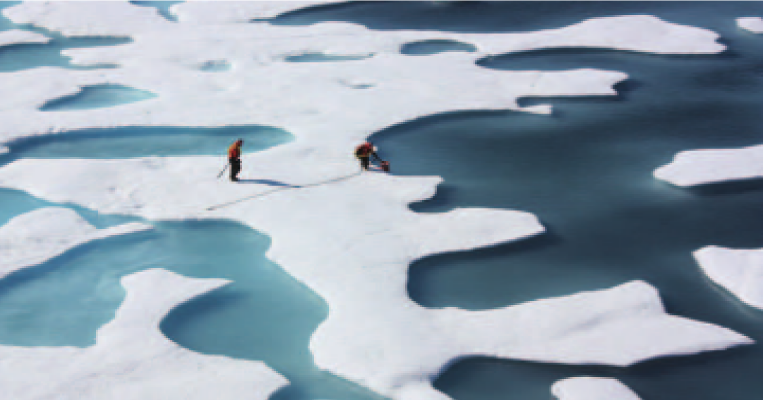
Fourteen researchers from Arizona State University want to save the Arctic ice sheet by deploying up to 100 million ice-making machines at a cost of about $5 trillion over the next 10 years. Essentially, wind-powered pumps will spread ocean water over ice where it will freeze and thicken the sea ice. Their proposal was published January 24, 2017, in Earth’s Future, an open access journal of the American Geophysical Union. You can read their full paper here:
The researchers claim that loss of Arctic sea ice is due to global warming caused by human release of CO2 (they don’t provide any evidence). Thus, there is an “urgent need to deal with climate change.” Within the paper they invoke all the usual boogeymen of dangerous global warming alarmism.
The paper abstract begins: “As the Earth’s climate has changed, Arctic sea ice extent has decreased drastically. It is likely that the late-summer Arctic will be ice-free as soon as the 2030s. This loss of sea ice represents one of the most severe positive feedbacks in the climate system, as sunlight that would otherwise be reflected by sea ice is absorbed by open ocean. It is unlikely that CO2levels and mean temperatures can be decreased in time to prevent this loss, so restoring sea ice artificially is an imperative.”
Their ice-making machine:
“We propose that a wind pump mounted on a large buoy, could perform the function of capturing wind energy to pump seawater to the surface. The basic components of such a device would include: a large buoy; a wind turbine and pump, drawing up seawater from below the ice; a tank for storing the water; and a delivery system that takes the water periodically flushed from the tank and distributes it over a large area. The goal is to raise enough water over the Arctic winter to cover an area approximately 0.1 km2 with approximately1 m of ice. A system of such devices would have to be manufactured and delivered to the Arctic Ocean, probably repositioned each season, and would need to be maintained.”
The researchers recognize “it is a challenge to prevent the water inside the device (tank, delivery system) from freezing.” But, they provide no solution. Where will they get energy to heat the water to prevent a freeze? They also say that the buoy-turbine contraption must be sturdy enough to prevent it tipping over in the fickle Arctic environment.
The researchers propose starting small with only 10 million pumps at a cost of $500 billion. They say we would need 100 million devices costing $5 trillion to cover the entire Arctic.
In my opinion, this is just another wacky and completely unnecessary geo-engineering scheme. It is also a complete waste of money and resources. Within the paper is a discussion of the need for a multinational governance of the Arctic ice. This seems to me to be a plea for more bureaucracy and future funding. Why 14 authors for this paper? Maybe the group wants to get “publish or perish” credit, which is vital in academia, before President Trump pulls the plug. Or, it could be a class project with professors and students. By the way, a note in the paper says: “The authors received no funding to carry out this work.” That probably means they had no special grant funding. I presume that the University pays the professors a salary (with taxpayer’s money).
I saw no mention in the paper of an unintended consequence of freezing ocean water: it will increase the amount of CO2 released into the atmosphere. “When sea water freezes, all of the CO2 that is bound up in that water is forced out. Not only is the dissolved gaseous CO2 released, but all of the CO2 held in the carbonate form is released as well.” (Source)
See also:
- Predictions of an ice-free Arctic Ocean
- Wacky Geoengineering Schemes to Control Climate
- The Arctic-Antarctic seesaw
Note to readers:
- Index with links to all my ADI articles: http://wp.me/P3SUNp-1pi
- My comprehensive 28-page essay on climate change: http://wp.me/P3SUNp-1bq
- A shorter ADI version is at https://arizonadailyindependent.com/2013/08/01/climate-change-in-perspective/
Melt pools on melting sea-ice (courtesy of NASA)
